Photo

NGC 5128, aka Centaurus A, at a distance of 10–16 million light-years is one of the closest radio galaxies to Earth and is debated to be a lenticular galaxy or a giant elliptical galaxy. (What do you think it is?). What's cool about this galaxy? The center of the galaxy contains a supermassive black hole with a mass of 55 million solar masses. It's been weeks of rain and cloud since my last deep sky imaging session, so when I saw the sky clearing up, I knew I had to shoot. Althought, I did not a target in mind, I looked of telescopius.com and the recommended targets were Centaurus A and Southern pinwheel galaxy. With a very scientific method of asking my wife what to shoot? We ended up choosing Centaurus A and I am glad I did. I've shot so many deep sky objects in the past, but this I think is the 2nd galaxy (not including LMC and SMC) I've shot and it's not an easy task shooting and processing galaxies in general, but the end result is worth it. The images were captured using N..I.N.A and processed using Pixinsight. The image was 2x drizzled in Pixinsight to get that details on this one, as I had to crop almost 60% to get the framing I wanted. Basic LRGB workflow was used and Individual frames were calibrated using darks and combined using channel combination. Once the RGB image was combined, I used the RGB combination and Light as Luminance. ACDNR was used for noise reduction and curves for colour saturation and correction. Final cropping and exporting for the web were done in Photoshop. Also, found that one of the images had a stream of satellites passing by, luckily it was only one frame I had to throw away from final stack. Swipe left to see more tightly cropped image and frame with satellites. Also, you can see how much I had to crop to get the framing I wanted. Details: - QHY294M Pro, 47MP read-out - AT65EDQ - CEM60 - ZWO EFW Mini - Badder LRGB 31mm filters - N.I.N.A, Pixinsight, and Photoshop Integration - 30x120sec LRGB each, Gain 200 - Total 4Hr integration (at Tauranga, New Zealand) https://www.instagram.com/p/CNzVNyXp6Ts/?igshid=1kkgh1cm7rwi5
0 notes
Photo
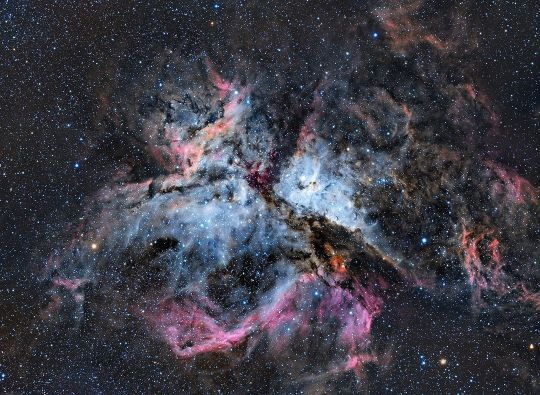
Eta carina nebula aka Grand nebula or the great carina nebula. One of the largest nebula complex of bright and dark nebulosity located in the carina-Sagittarius arm of the milky-way. The nebula is home to some of the youngest star clusters like Trumpler 14,15,16, Globules, Stellar Jet, and the most fascinating Eta-carina star, because of which the nebula gets its name. Eta Carina is currently the most massive that can be studied in great detail. Eta Carinae's effects on the nebula can be seen directly. Dark globules and some other less visible objects have tails pointing directly away from the massive star. The entire nebula would have looked very different before the Great Eruption in the 1840s surrounded Eta Carinae with dust, drastically reducing the amount of ultraviolet light it put into the nebula. Swipe left to see cropped and highly detailed parts of the image. The images were captured using N..I.N.A and processed using Pixinsight. The image was 2x drizzled in Pixinsight to get that details out of the faint objects. Basic Ha-RGB workflow was. Individual frames were calibrated using darks and combined using channel combination. Once the RGB image was combined, I used the LRGB combination to combine Ha data as Luminance. ACDNR was used for noise reduction and curves for colour saturation and correction. Final cropping and exporting for the web were done in Photoshop. Details: - QHY294M Pro, 47MP read-out - AT65EDQ - CEM60 - ZWO EFW Mini - Badder RGB-Ha 31mm filters - N.I.N.A, Pixinsight, and Photoshop Integration - 15x120sec RGB each, Gain 200 - 60x120sec 7nm Ha, Gain 200 - Total 3.5Hr integration • • • • • #astrophotography #milkyway #nightsky #stars #astronomy #space #galaxy #universe #nightscape #nightscaper #astrophoto #qhyccd #starrynight #skywatcher #nebula #astro #nasa #telescope #cosmos #photography #astronomia #celestron #universetoday #astrofotografia #ioptron #milkywaychasers #natgeospace #ig_astrophotography #astrophysics #cem60 (at Tauranga, New Zealand) https://www.instagram.com/p/CLlX6rDJjWv/?igshid=guqcyonqyk4k
#astrophotography#milkyway#nightsky#stars#astronomy#space#galaxy#universe#nightscape#nightscaper#astrophoto#qhyccd#starrynight#skywatcher#nebula#astro#nasa#telescope#cosmos#photography#astronomia#celestron#universetoday#astrofotografia#ioptron#milkywaychasers#natgeospace#ig_astrophotography#astrophysics#cem60
0 notes
Photo
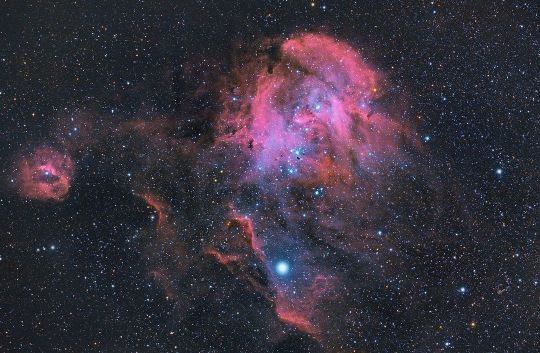
Gum 41, IC 2944 and Lambda Centauri This image covers the area of the southern sky nebulosity associated with the open cluster IC 2944 aka The running chicken nebula. The interesting parts of this nebula are the bok globules in the central region. These were discovered in 1950. Generally, these globules are associated with star formation but no evidence for star formation has been found in any of the globules. The bottom bright star is Lambda Centauri. Although it's in the nebula it has no association with it, most likely because it's only 420 Light years away, where the open cluster is roughly 6,500 Light years away. GUM 41 on the left of the image is another star-forming region currently being illuminated by brilliant hot young stars. At the time of annotating the image, I had no idea what the planetary nebula is but later found out that it is a planetary nebula pk-294-0-1, very rarely imaged. The images were captured using N..I.N.A and processed using Pixinsight. Basic Ha-RGB workflow was used and final cropping and exporting for the web was done in Photoshop. I also used Pixinsight workflows by @galactic.hunter and their amazing advance PDF (I always refers to it) Also, was impressed by the 47MP read-out mode, The noise was significantly lower than 11MP read mode, will post details later. Details: - QHY294M Pro, 47MP read-out - AT65EDQ - CEM60 - ZWO EFW Mini - Badder RGB 31mm filters - N.I.N.A, Pixinsight and Photoshop Integration - 10x120sec RGB each, Gain 200 - 15x120sec 7nm Ha, Gain 200 - Total 1Hr integration • • • • • #astrophotography #astronomy #nightsky #space #stars #galaxy #nasa #universe #cosmos #deepsky #milkyway #qhyccd #skywatcher #nebula #astro #telescope #astronomer #photography #science #cosmology #astronomia #constellation #celestron #interstellar #astronomyphotography #astrofotografia #hubbletelescope #ioptron #nasabeyond #nebulae (at Tauranga, New Zealand) https://www.instagram.com/p/CLOysfkJI2y/?igshid=gcq26g9g5g05
#astrophotography#astronomy#nightsky#space#stars#galaxy#nasa#universe#cosmos#deepsky#milkyway#qhyccd#skywatcher#nebula#astro#telescope#astronomer#photography#science#cosmology#astronomia#constellation#celestron#interstellar#astronomyphotography#astrofotografia#hubbletelescope#ioptron#nasabeyond#nebulae
0 notes
Photo
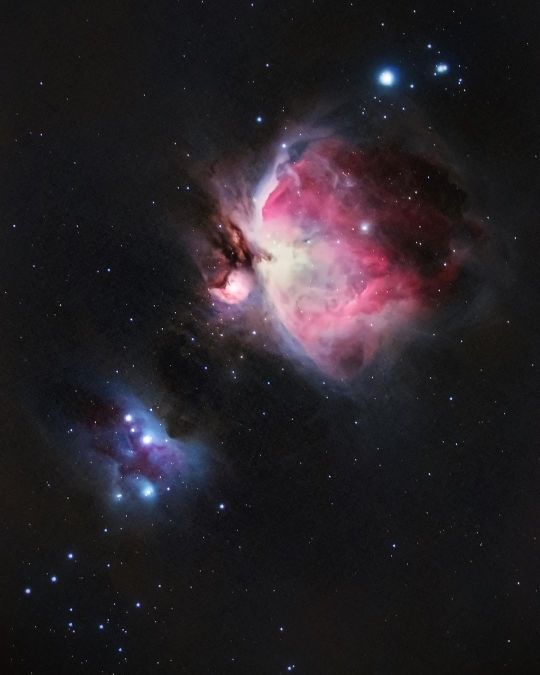
The clouds decided to ruin the night as soon as I put my mount outside. Within 5 minutes the sky went from crystal clear to cloudy AF. While I sat there watching the sky get worse and the moon rise, I went through some images I took last week with brand new @qhyccd_astropic 294M pro and badder RGB filters. I am impressed with this images, as it is probably one of the good ones I’ve had of Orion. It is noisy but read the acquisition data below to see why. I used Pixinsight to combine the images and N.I.N.A for acquisition. I used general workflow for RGB images. The image was cropped and used astronomy tools to add a bit of contrast and camera raw for more noise reduction in photoshop. Details: - QHY294M Pro, 11MP read-out - AT65EDQ - CEM60 - ZWO EFW Mini - Badder RGB 31mm filters - N.I.N.A, Pixinsight and Photoshop Integration - 3x120sec RGB, Gain 1087 - 6 Min Total integration • • • • • #nasa #astronomy #space #astrophotography #cosmos #galaxy #universe #milkyway #stars #science #nightsky #stargazing #hubble #nebula #universetoday #astronomia #planets #solarsystem #telescope #astrophysics #astronaut #astro_photography_ #astronomi #constellation #interstellar #astrophoto #uzay #ig_astrophotography #nightscaper #nasabeyond (at Tauranga, New Zealand) https://www.instagram.com/p/CKtQnKUJF2Q/?igshid=1aqkffze2gaai
#nasa#astronomy#space#astrophotography#cosmos#galaxy#universe#milkyway#stars#science#nightsky#stargazing#hubble#nebula#universetoday#astronomia#planets#solarsystem#telescope#astrophysics#astronaut#astro_photography_#astronomi#constellation#interstellar#astrophoto#uzay#ig_astrophotography#nightscaper#nasabeyond
0 notes
Photo
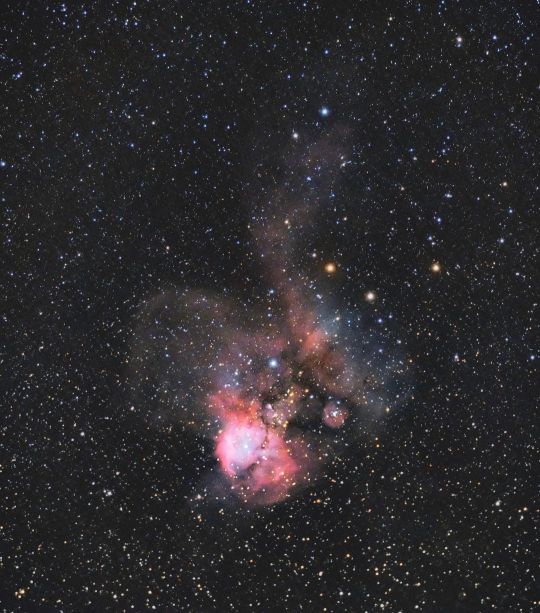
NGC 2467 nicknamed the "Skull and Crossbones Nebula” located in the southern constellation of Puppis ("The Stern"). With an age of a few million years at most, it is a very active stellar nursery, where new stars are born continuously from large clouds of dust and gas. NGC 2467 is not one distinct open cluster, but is a superposition of very different stellar objects along our line of sight. This was my first try at this object with almost 90% moon. Will have to give this a go again. I did make plenty of mistakes and learnt from them. I am still waiting on few extender so I can get a proper back focus on the new QHY294M camera. Currently it sits right on the edge of focus draw tube and at times has a tilt (during this image) also, in N.I.N.A I forgot to put filter offsets and run AF routine after filter change so green and blue filters were a bit out of focus. I used Pixinsight to stack and calibrate the images and N.I.N.A for acquisition. I used general workflow for Ha-RGB. I also used the Ha data as Luminance for this image. The image was finished in photoshop. Details: - QHY294M Pro, 11MP read-out - AT65EDQ - CEM60 - ZWO EFW Mini - Badder LRGB-Ha 31mm filters - N.I.N.A, Pixinsight and Photoshop Integration - 6x300sec Ha, Gain 1087 - 3 x 300sec R,G,B, Gain 1087 - 1.25 Hrs Total integration - Moon was 90% • • • • • #astrophotography #astronomy #nightsky #space #nasa #galaxy #cosmos #milkyway #stars #universe #science #constellation #interstellar #nasabeyond #astro_photography_ #stargazing #deepsky #nightscaper #universetoday #astronomer #cosmology #astronomyphotography #astrophoto #hubbletelescope #nebulae #astroglore #astronaut #spacetime #discovery #galactic (at Tauranga, New Zealand) https://www.instagram.com/p/CKgYE0KpCFa/?igshid=kxbmspkmfkem
#astrophotography#astronomy#nightsky#space#nasa#galaxy#cosmos#milkyway#stars#universe#science#constellation#interstellar#nasabeyond#astro_photography_#stargazing#deepsky#nightscaper#universetoday#astronomer#cosmology#astronomyphotography#astrophoto#hubbletelescope#nebulae#astroglore#astronaut#spacetime#discovery#galactic
0 notes
Photo
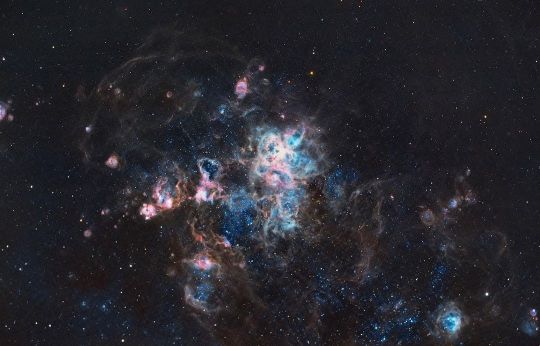
Tarantula nebula aka 30 Doradus and surrounding region. A Hii region in the Large Magellan Cloud, roughly 170,000 light years away. It is the brightest star-forming region visible in a neighboring galaxy, and it is home to the most massive stars ever seen. No known star-forming region inside the Milky Way Galaxy is as large or as prolific as 30 Doradus. The region's sparkling centerpiece is a giant, young star cluster named NGC 2070, only 2 million to 3 million years old, packed with several dozen of the most massive stars known, each about 100 times the mass of the Sun and about 10 times as hot. The surrounding region shows other brilliant nebula around the region. This is my first image shot with the new @qhyccd_astropic 294M Pro. Although I did struggle few days to get it up and running but it was worth at the end. The image was taken from my driveway which is under a Bortle scale 5 sky. I was certainly impressed with the result I got. Looking forward to shooting more images with this camera. I used Pixinsight to stack and calibrate the images and N.I.N.A for acquisition. I used general workflow for Ha-RGB and used photometric colour calibration in pixinsight to get the colours right. I also used the Ha data as Luminance for this image. The image was finished in photoshop. Details: - QHY294M Pro, 11MP read-out - AT65EDQ - CEM60 - ZWO EFW Mini - Badder LRGB-Ha 31mm filters - N.I.N.A, Pixinsight and Photoshop Integration - 6x300sec Ha, again 1087 - 1 x 300sec RGB, Gain 1087 - 40min Total integration (at Tauranga, New Zealand) https://www.instagram.com/p/CKYBeKfp5yL/?igshid=1stw0r3b0y652
0 notes
Photo
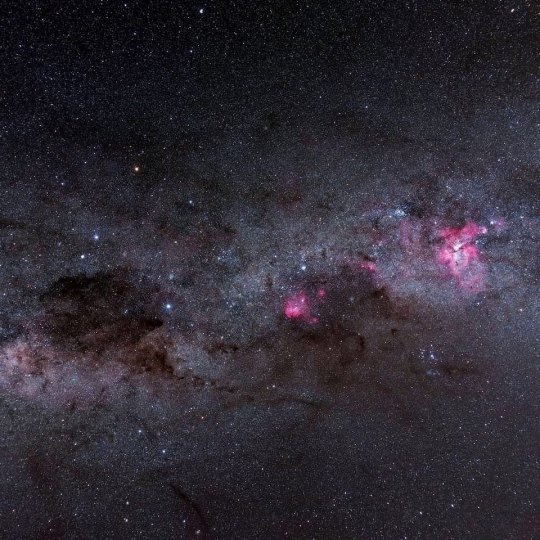
Southern Jewels A very rich part of the southern sky, home to the extreme star birth region carina , IC 2944 another star forming region also known as the Running Chicken Nebula and many other star clusters including the jewel box and southern pleiades. Running Chicken Nebula is an open cluster with an associated emission nebula found in the constellation Centaurus, near the star Lambda Centauri. It features Bok globules, which are frequently a site of active star formation. Below Carina is a group of stars (Open cluster ) called is Southern Pleiades Southern Cross / Crux is the smallest yet one of the most distinctive of the 88 modern constellations. Coal Sack Nebula is the most prominent dark nebula in the skies, easily visible to the naked eye as a dark patch silhouetted against the southern Milky Way. It is located at a distance of approximately 600 light years away from Earth, in the constellation Crux. (Dark Patch just below crux and on left of the image) This image is a stack of 5 x 2 set of images. 5 with Astronomik CLS Filter and 5 without the filter. I used the filter to get as much H-Alpha colour possible, which without a modded camera shows really faint in the image. Total exposure for the image is 122 x 10 = 1220 sec = 20.33 min. I wanted to a bit more on this area but had to leave as it was late and this region was getting close to horizon and light pollution. The images were shot by Canon 50mm on Canon 6D and tracked using iOptron ZEQ25 from Warkworth Satellite Station, New Zealand. Exif for each frame: 122 sec, f2.8 with Canon 50mm f1.8 on Canon 6D (With Filter) : ISO 3200 (Without Filter) : ISO 800 WB and Lens Correction in Lightroom and Median Stacked and Processed in Photoshop. (at Warkworth, New Zealand) https://www.instagram.com/p/CKLpJUqpo_a/?igshid=fwmh7bmp5obr
0 notes
Photo

Seems like this season hasn’t been great for deep sky. On nights where you think the sky is clear there are high clouds. These clouds seems to affect the images drastically, weird gradients and not the best signal to noise ratio. Last night I spent about 2 hrs before clouds rolled in. This is Orion in Ha-RGB. In the past 2 hrs of data has revealed some great details, but this 2 hr data was a struggle to process. Orion and horse head nebula. The target was just Orion, I knew at 200mm horse head nebula would be in frame but did not want to keep in final image, but since I struggled to bring more details form orion, I kept horse head in. Canon 6D (modded) Askar 200mm f/4 120sec x 30 + 120sec x 30 (Ha) ISO 800, ISO 3200 IOptron Sky guider pro Processed in Pixinsight and Photoshop. • • • • • #astrophotography #milkyway #nightsky #stars #astronomy #nightscape #nightscaper #astrophoto #starrynight #universetoday #milkywaychasers #natgeospace #ig_astrophotography #nightphotography #longexposure #milkywaygalaxy #stargazing #space #galaxy #astro_photography_ #longexpo #lunar #themoon #nightimages #moon #nightshooters #nightscapes #skymasters #starrysky #thestars (at Tauranga, New Zealand) https://www.instagram.com/p/CKI9KmspAgT/?igshid=oquef2p09uzj
#astrophotography#milkyway#nightsky#stars#astronomy#nightscape#nightscaper#astrophoto#starrynight#universetoday#milkywaychasers#natgeospace#ig_astrophotography#nightphotography#longexposure#milkywaygalaxy#stargazing#space#galaxy#astro_photography_#longexpo#lunar#themoon#nightimages#moon#nightshooters#nightscapes#skymasters#starrysky#thestars
0 notes
Photo
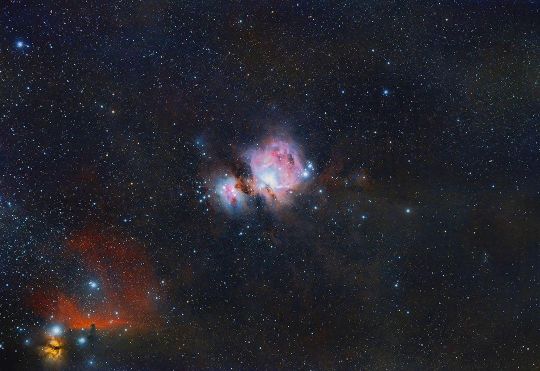
Seems like this season hasn’t been great for deep sky. On nights where you think the sky is clear there are high clouds. These clouds seems to affect the images drastically, weird gradients and not the best signal to noise ratio. Last night I spent about 2 hrs before clouds rolled in. This is Orion in Ha-RGB. In the past 2 hrs of data has revealed some great details, but this 2 hr data was a struggle to process. Orion and horse head nebula. The target was just Orion, I knew at 200mm horse head nebula would be in frame but did not want to keep in final image, but since I struggled to bring more details form orion, I kept horse head in. Canon 6D (modded) Askar 200mm f/4 120sec x 30 + 120sec x 30 (Ha) ISO 800, ISO 3200 IOptron Sky guider pro Processed in Pixinsight and Photoshop. • • • • • #astrophotography #milkyway #nightsky #stars #astronomy #nightscape #nightscaper #astrophoto #starrynight #universetoday #milkywaychasers #natgeospace #ig_astrophotography #nightphotography #longexposure #milkywaygalaxy #stargazing #space #galaxy #astro_photography_ #longexpo #lunar #themoon #nightimages #moon #nightshooters #nightscapes #skymasters #starrysky #thestars (at Tauranga, New Zealand) https://www.instagram.com/p/CKI9KmspAgT/?igshid=oquef2p09uzj
#astrophotography#milkyway#nightsky#stars#astronomy#nightscape#nightscaper#astrophoto#starrynight#universetoday#milkywaychasers#natgeospace#ig_astrophotography#nightphotography#longexposure#milkywaygalaxy#stargazing#space#galaxy#astro_photography_#longexpo#lunar#themoon#nightimages#moon#nightshooters#nightscapes#skymasters#starrysky#thestars
0 notes
Photo
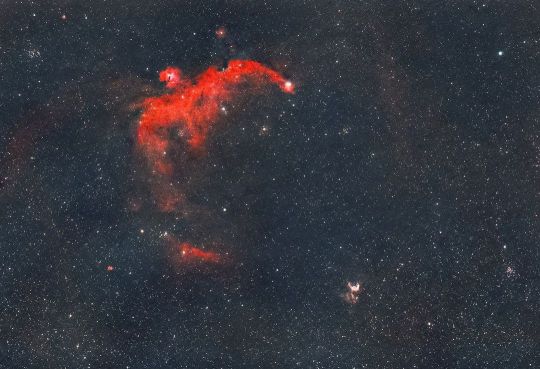
This wide field region of Monoceros and Canis Major is home to one of the most prominent nebula in the region, The seagull nebula. The wings of seagull (IC2177) spans around 250ly and is roughly 3000ly away from us. In the right bottom is the Thor’s helmet nebula (NGC 2359). The central star is the Wolf-Rayet star WR7, an extremely hot star thought to be in a brief pre-supernova stage of evolution. It is similar in nature to the Bubble Nebula, but interactions with a nearby large molecular cloud are thought to have contributed to the more complex shape and curved bow-shock structure of Thor's Helmet. Canon 6D (modded) Askar 200mm f/4 60sec x 60 (RGB), 60sec x 60 (Ha) CEM60 • • • • • #astronomy #astrophotography #milkyway #nasa #nebula #space #galaxy #cosmos #stars #nightsky #astro_photography_ #stargazing #astronaut #nightscaper #universetoday #universe #astrophoto #ig_astrophotography #hubble #astronomia #science #telescope #nightscape #milkywaychasers #starrynight #astrophysics #natgeospace #astronomi #planets #constellation (at Tauranga, New Zealand) https://www.instagram.com/p/CJ7p2rFpXMa/?igshid=pftc6036fhpv
#astronomy#astrophotography#milkyway#nasa#nebula#space#galaxy#cosmos#stars#nightsky#astro_photography_#stargazing#astronaut#nightscaper#universetoday#universe#astrophoto#ig_astrophotography#hubble#astronomia#science#telescope#nightscape#milkywaychasers#starrynight#astrophysics#natgeospace#astronomi#planets#constellation
0 notes
Photo

Another unexpected clear night that did not last very long as high clouds came in and despite being summer there was a lot of moisture because of rain and the lens fogged up. Anyway, ended up doing a quick go at Orion and Monoceros wide field. Will get some more RGB data on this to overlay the Ha data. Unfortunately, I could not get the focus right with my UHC filter and hence the stars look a bit bloated and out of focus but I am happy with the Ha data captured. On the left is the Orion region and on right is the Monoceros region. I’ve never seen a Monoceros wide field and I think it’s pretty amazing region. Might also try the seagull and rosette nebula later on. Canon 6D (modded) Astronomik 12na Ha filter Samyang 24mm f/1.4 lens ISO 6400, f/2.8 iOptron SkyGuider pro • • • • • #astronomy #astrophotography #space #nightsky #universe #stars #nasa #cosmos #galaxy #science #constellation #interstellar #nebula #nasabeyond #orion #deepsky #sky #astronomer #cosmology #love #astronomyphotography #hubbletelescope #nightphotography (at Tauranga, New Zealand) https://www.instagram.com/p/CJz0vu0px-4/?igshid=1ci749bf6oe9r
#astronomy#astrophotography#space#nightsky#universe#stars#nasa#cosmos#galaxy#science#constellation#interstellar#nebula#nasabeyond#orion#deepsky#sky#astronomer#cosmology#love#astronomyphotography#hubbletelescope#nightphotography
0 notes
Photo
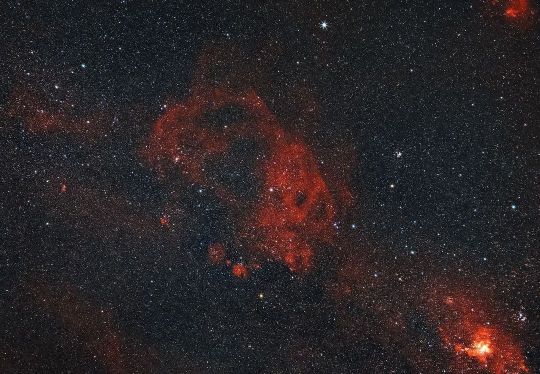
The Gum nebula, a very large Hii region in the southern sky, that is very large and so close to us that it’s hard to see it. Named after late Australian astronomer Colin gum. Home to Vela SNR and Vela pulsar. This regions shows the gun nebula expanding around 40+deg across the constellation puppies and vela. At the bottom right is the carina nebula region. The weather has been a bit rough here for the last few weeks until yesterday, really thought it would be a beautiful clear one, until I decided to put the camera out. As soon as I put it out, the clouds started rolling in within minutes and over a period of 30min they took over. Since I have t shot anything for a while, I left the camera out and kept shooting the target I want to get more data on. The Gum nebula. Hopefully can get more data on this. - Canon 6D (modded) - Astronomik 12nm Ha - 120sec x 10 + 120sec x 2 - ISO 6400, ISO 800 - iOptron Sky guider pro. Background extracted using starnet++ from both Ha and clear image and merged together. Swipe left to see the starless version and annotated version. Also, click here to see this image as an overlay in world wide telescope. https://tinyurl.com/y6m82zzq (at Tauranga, New Zealand) https://www.instagram.com/p/CJrJ4vfJjlm/?igshid=o1vma7on9icw
0 notes
Photo
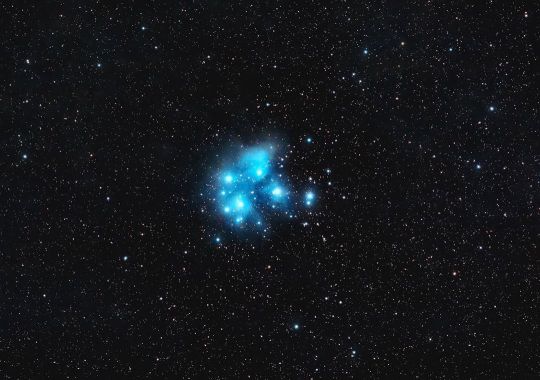
It’s summer in Southern Hemisphere and it’s time to shoot the summer sky. Starting with the 7 sisters aka Pleiades aka Matariki. In Maori culture this cluster is a marker of the beginning of the new year which is late may or early June. It’s only until later in Oct/Nov that it gets high enough and early in the sky so we can shoot it all night. Canon 6D Astronomik UHC filter Askar 200mm f/4 @ioptron_telescopes Sky Guider Pro 120sec x 120, ISO 1600 #astronomy #space #galaxy #universe #stars #astrophotography #nasa #cosmos #astronaut #nightsky #science #nebula #constellation #interstellar #nasabeyond #matariki #deepsky #nzartist #artwork #blackhole #digitalart #illustration #imagination #ipadpro #astronomer #multiverse #cosmology #nzillustrator #astronomyphotography #wonder (at Tauranga, New Zealand) https://www.instagram.com/p/CGhMwB1p04_/?igshid=1r4lfzuie5ji1
#astronomy#space#galaxy#universe#stars#astrophotography#nasa#cosmos#astronaut#nightsky#science#nebula#constellation#interstellar#nasabeyond#matariki#deepsky#nzartist#artwork#blackhole#digitalart#illustration#imagination#ipadpro#astronomer#multiverse#cosmology#nzillustrator#astronomyphotography#wonder
0 notes
Photo

NGC 6604, Eagle nebula aka Star Queen nebula (which I prefer) and the Omega nebula (Swan nebula) The eagle nebula is one of the regions that originally got me interested in astronomy and space. It was an image of pillar of creation taken in 1995 that o saw in a magazine in 1998 that made me go wow. It gives me so much pleasure and excitement that you can shoot the same target from the drive-way. Although you can just barely see that region in this image, the fact that you know it’s there is amazing. Probably will add more data to this in the future. HaRGB: 2hrs + 1hr Canon 6d Askar 200mm f/4 @ioptron_telescopes Sky Guider Pro Swipe left to see the Ha version and starless version. (at Tauranga, New Zealand) https://www.instagram.com/p/CGHaWVwJn49/?igshid=2f46ex81d8c
0 notes
Photo

NGC6188 aka The fighting dragons of ara, is an emission nebula located about 4,000 light years away in the constellation Ara. The bright open cluster NGC 6193, visible to the naked eye, is responsible for a region of reflection nebulosity within NGC 6188. NGC 6188 is a star forming nebula, and is sculpted by the massive, young stars that have recently formed there – some are only a few million years old. This spark of formation was probably caused when the last batch of stars went supernova. Image also show NGC 6164 which is a bipolar emission nebula of about 4 light-years across that lies some 4,200 light-years away in the southern constellation of Norma. It is approaching us at approximately 53.9 kilometers per second. Its symmetric gaseous shroud and faint halo surround the blue, young, central star HD 148937, the brightest member of a triple star system orbiting around each other, which fierce stellar winds – of about 8 million kilometers per hour – created this nebula. Swipe left to see more details of this beautiful region in Ha. If you look closely you can just make our the beautiful shells of NGC 6164 📷: 1 hour of 12nm Ha data with 30min of RGB with modded and stock 6D 🔭: AT65EDQ on @ioptron_telescopes Sky guider pro (at Tauranga, New Zealand) https://www.instagram.com/p/CFoWb10p_y1/?igshid=1isqgpo5xs65o
0 notes
Photo
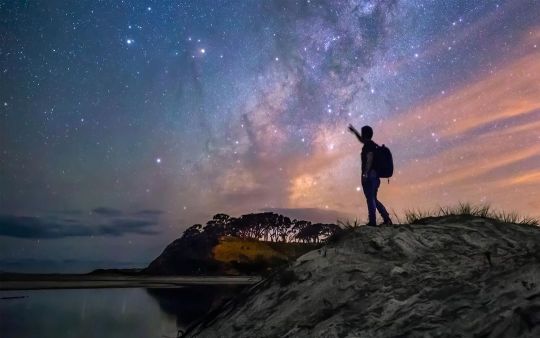
Just reaching for the stars.... #astrophotography #milkyway #nightscaper #astro_photography_ #nightsky #astronomy #nightscape #starrynight #astrophoto #universetoday #ig_astrophotography #stars #milkywaychasers #space #natgeospace #stargazing #longexposure #galaxy #nightphotography #nightimages #nightshooters #skymasters #nasa #longexpo #fs_longexpo #longexposure_shots #cosmos #milkywaygalaxy #universe #rsa_night (at Pakiri, New Zealand) https://www.instagram.com/p/CFg8ZhPJoSr/?igshid=y09uvy0r95y
#astrophotography#milkyway#nightscaper#astro_photography_#nightsky#astronomy#nightscape#starrynight#astrophoto#universetoday#ig_astrophotography#stars#milkywaychasers#space#natgeospace#stargazing#longexposure#galaxy#nightphotography#nightimages#nightshooters#skymasters#nasa#longexpo#fs_longexpo#longexposure_shots#cosmos#milkywaygalaxy#universe#rsa_night
0 notes
Photo
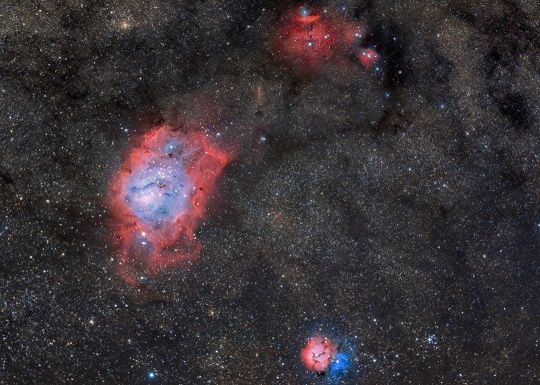
Lagoon nebula and friends. The image shows Lagoon and Trifid nebula along with NGC 6559 at the top. All these nebulae are star forming regions. Lagoon and trifid nebula are around 4100 Light years away whereas NGC 6559 around 5000. Where Lagoon nebula is filled with Bok Globules (possible star forming regions) Trifid nebula houses embryonic stars. Isin’t this an amazing piece of sky. This area is one of the few that can be spotted with the naked eye under a dark sky and through a decent scope is viewed as fuzzy grayscale object with bright centre. @canon.nz 6D AT65EDQ @ioptron_telescopes Sky guider pro Total time: 1.5 hrs (1hr Ha + 30min RGB) DSS, Pixinsight and Photoshop Swipe left to see more images that let to this final one. 1. DSS Stack 2. DSS Stack stretches 3. Ha stack 4. Ha Red channel starless 5. Ha + RGB, Ha used as luminance layer 6. Annotated image Also, thanks to @galactic.hunter for the pixinsight course. Learnt new tricks especially colour masks, really helped. Go check out their profile. #astrophotography #astronomy #space #galaxy #stars #universe #milkyway #cosmos #nightsky #deepsky #nasa #science #nebula #astro #cosmology #interstellar #astronaut #spacetravel #hubbletelescope #spaceart #astrophoto #nightphotography #milkywaychasers #nightscape #longexposure #natgeospace #ig_astrophotography #deepspace #ioptron #longexposure_shots (at Tauranga, New Zealand) https://www.instagram.com/p/CFE0Alxp82g/?igshid=2ljseiwh9dmp
#astrophotography#astronomy#space#galaxy#stars#universe#milkyway#cosmos#nightsky#deepsky#nasa#science#nebula#astro#cosmology#interstellar#astronaut#spacetravel#hubbletelescope#spaceart#astrophoto#nightphotography#milkywaychasers#nightscape#longexposure#natgeospace#ig_astrophotography#deepspace#ioptron#longexposure_shots
0 notes